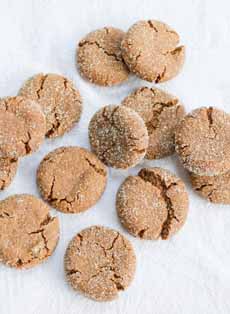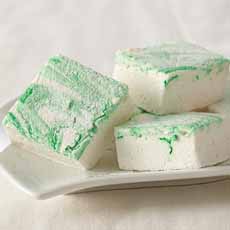|
December 23rd is National Pfeffernüsse Day, celebrating a traditional German Christmas cookie: rounded, spicy, and coated in powdered sugar.
Pronounced FEH-fehr-NEE-suh, the word means “pepper nuts.” The “nuts” refer to the nut-like hardness of the cookie; there are no nuts in the recipe.
Rather, these cookies are laden with gingerbread spices (anise, cloves, nutmeg), and pepper, plus citron*, candied lemon peel, and/or candied orange peel. The black pepper adds to the spiciness without adding heat. The result is sweet pepperiness.
Spices will vary by the baker. We’ve seen some recipes that substitute paprika for pepper; some add vanilla to the mix.
Some use creative garnishes, like candied fruit (photo #3) and crushed pink peppercorns (photo #5). Or dip their bottoms in chocolate (photo #4).
Some get out the cookie cutters and make star or Christmas tree shapes.
The flavor deepens as the cookies sit, so some bakers prepare them at the onset of the holiday season, enjoying them throughout the month of December [source].
The recipe below doesn’t use the candied citrus peel, but here’s one that does. Another variation: Pfeffernusse topped with royal icing and cubes of candied citrus peel.
> The pfeffernüsse recipe, below.
> Beverages to pair with pfeffernüsse.
> The difference between pfeffernüsse and lebkuchen, below.
> The history of pfeffernüsse, below.
> The different types of cookies: a photo glossary.
> The history of cookies.
PFEFFERNÜSSE VS. LEBKUCHEN: THE DIFFERENCE
Pfeffernüsse are similar to Lebkuchen, but the latter are flat spice cookies topped with a thin white icing or chocolate glaze, while as previously mentioned, Pfeffernüsse are almost always small, rounded cookies with a powdered sugar glaze.
Instead of powdered sugar, Lebkuchen can be iced or dipped in chocolate. In photo #4, the baker did both! Lebkuchen can be shaped like regular cookies or cut into bars.
Pfeffernüsse and lebkuchen are both similarly flavored with honey and lots of warm baking spices
Some people think Lebkuchen are gingerbread, but they’re different†.
To soften the hard cookie, Lebkuchen (and Pfeffernüsse without powdered sugar) are often dunked in sweet wine, similar to the Italian practice of dunking biscotti in vin santo.
PFEFFERNÜSSE BEVERAGE PAIRINGS
Non-Alcoholic Beverages
Hot Beverages: coffee, hot chocolate, mulled cider or wine, spiced tea (chai, Constant Comment, and numerous others).
Cold Beverages: iced coffee or chai, milk.
Alcoholic Beverages
Beer: chocolate stout, dark beer, or porter.
Dessert wines: sweet German wines like Eiswein, Spätlese Riesling or Auslese Riesling. In the footnote below‡‡ are more dessert wines from the Continent and the New World.
Others: eggnog, spiced rum.
RECIPE: PFEFFERNÜSSE SPICE COOKIES
This recipe is from Pillsbury. Grinding whole spices provides a more exciting flavor than using pre-ground spices. Here’s more about it.
You’ll love the aroma that wafts through the house as the cookies bake.
Ingredients
2/3 cup butter, softened
2/3 cup firmly packed brown sugar
1/3 cup molasses
1/3 cup water
2-1/2 cups all-purpose flour
1 teaspoon cinnamon
1/2 teaspoon baking soda
1/4 teaspoon salt
1/4 teaspoon anise seed
1/4 teaspoon nutmeg
1/4 teaspoon cloves
1/8 teaspoon cardamom
1/8 teaspoon pepper
1 cup chopped nuts
1 cup powdered sugar
|
|
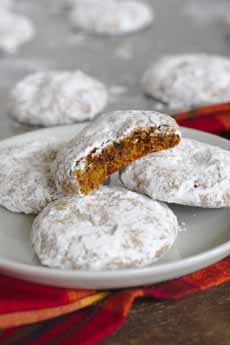
[1] Classic Pfeffernusse. Some cookies are flatter, some rounder, depending on the consistency of the dough. Here’s the recipe from Mildly Meandering.

[2] If you don’t want a lot of powdered sugar, sift it over the cookies instead of rolling them in the sugar. Here’s the recipe from McCormick.
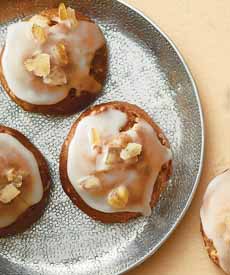
[3] Instead of powdered sugar, use royal icing. This version tops it with candied citrus peel (recipe—it’s lemon peel, not candied citron). Here’s the recipe from Chatelaine.
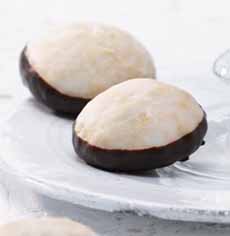
[4] Why choose: Use both royal icing and chocolate! Here’s the recipe from Alnatura.
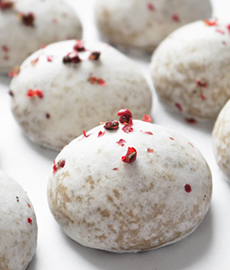
[5] An easy garnish: crushed pink peppercorns. Here’s the recipe from London Eats (photo © London Eats).
|
Preparation
1. COMBINE in a large bowl the butter and brown sugar; beat until light and fluffy. Stir in the molasses and water. Lightly spoon the flour into a measuring cup and level off. Add the flour, cinnamon, baking soda, salt, anise seed, nutmeg, cloves, cardamom, and pepper; blend well. Stir in the nuts. Cover with plastic wrap; refrigerate for 2 hours for easier handling.
2. PREHEAT the oven to 350°F. Shape the dough into 1-inch balls; place 1 inch apart on ungreased cookie sheets.
3. BAKE for 9 to 12 minutes or until the bottoms are golden brown. Immediately remove from the cookie sheets and roll in powdered sugar.
PFEFFERNÜSSE HISTORY
The exact origin of pfeffernüsse is uncertain, but they are believed to have first appeared in Europe in the 17th century. Whoever made them first, they are commonly linked to Denmark, Germany, and the Netherlands.
Pfeffernüsse, which translates to “pepper nuts,” were named for their use of pepper and chopped nuts.
In Germany, Pfeffernüsse has become a traditional Christmas cookie [source].
Pfeffernüsse, along with lebkuchen (gingerbread), gingerbread (Germany), pepparkakor (Sweden), speculaas (The Netherlands), plus subsequent entries like biscochito (Spain) and pryaniky (Russia), were made possible by the medieval spice trade, which brought exotic ingredients like cinnamon, cloves, nutmeg, and pepper to Europe. Trade evolved over time so that these early, extremely costly ingredients, were made affordable to regular folks.
Historically, pfeffernüsse were baked in December for St. Nicholas Day (December 6th), a significant festive occasion in many European countries (although St. Nicholas pre-dates the cookies). They have become a beloved Christmas treat across the pond as well, thanks to the emigration of Europeans bringing their recipes.
St. Nicholas, called Sinterklaas (Santa Claus)**, arrives in many parts of Europe, children leave out their shoes or stockings to be filled with small gifts on St. Nicholas Day.
In the 19th century, bakers incorporated potash or potassium carbonate (the primary component of potash), into the dough, along with ammonium carbonate. These acted as leavening agents to achieve a superior consistency.
The recipes became more sophisticated over time. The conventional ingredients—flour, sugar, brown sugar, cloves, and cinnamon—have been expanded over the years to include some of the following: anise, black pepper, candied fruit, cardamom, honey, molasses, nutmeg, nuts, rum, and powdered sugar for dusting [source].
________________
*Citron is a large, fragrant citrus fruit with a very thick rind. There is little fruit inside, and its main contribution is the candied peel. It is one of the four original citrus fruits—along with mandarin, papeda, and pomelo—from which all other citrus types developed through natural hybrid speciation or artificial hybridization. Here’s a photo.
**Sinterklaas is based on Saint Nicholas of Myra, a 4th-century bearded Greek bishop known for his generosity and miracles. The Santa Claus tradition evolved when the Dutch brought their celebration of Sinterklaas to New Amsterdam (modern-day New York) in the 17th century. The Sinterklaas tradition began to blend with other European customs such that eventually, a bearded jolly man named Santa Claus arrived on Christmas Eve, December 24th, larger gifts.
The English had Father Christmas, who appeared in the 16th century during the reign of Henry VIII. Pictured as a large man in green or scarlet robes lined with fur (like the king?), he was the spirit of good cheer at Christmas, bringing peace, joy, good food and wine and revelry. As Protestant England no longer kept the feast day of Saint Nicholas on December 6th, the Father Christmas celebration was moved to December 25th, Christmas Day.
The history of Santa Claus: In 1809, Washington Irving’s “Knickerbocker’s History of New York” mentioned “Saint Nicholas,” a jolly, pipe-smoking, gift-giving figure who traveled in a wagon. Irving Americanized the character, making him less of a bishop and more of a folklore figure. By the late 19th century, the American version of Santa Claus had spread internationally through advertising, literature, and the press. Though jump-started by Sinterklaas, Santa Claus—a jolly old portly, white-bearded elf in red suit, cap, and black boots—became the father of Christmas. Along the way were born The North Pole, elves who made gifts in a magical toy workshop, eight reindeer pulling Santa in his sled of gifts, and a jolly .
Today, Sinterklaas and Santa Claus coexist in their respective cultures, with Sinterklaas celebrated primarily in the Netherlands and Belgium, and Santa Claus being the central figure of Christmas celebrations worldwide.
†Both Lebkuchen and gingerbread are spice cookies, but Lebkuchen has more layers of flavor and is softer/chewier. Lebkuchen spices include aniseed, cardamom, cloves, coriander, ginger, nutmeg, and black pepper or paprika. Candied citrus peel—lemon and orange—are added. These spices are also used in Pfeffernüsse.
Vis-a-vis gingerbread, lebkuchen cookies use almond and hazelnut flours instead of wheat flour, and brown sugar instead of molasses. A classic lebkuchen cookie is gluten-free. Here’s a recipe and more about lebkuchen spices, Lebkuchengewürz in German.
The name of the cookie is uncertain. Kuchen is the German word for cake, but the “leb” portion might be any (or none) of the following: the Germanic words Laib (loaf), Lebbe (very sweet), or an old term for crystallized honey, Leb-Honig, that cannot be used for much beside baking. There’s also Leibspeise, which means “a favorite food.”
‡Pink peppercorns, also called red peppercorns or rose peppercorns, and rose baises, may look like black and white peppercorns (Piper nigrum, family Piperaceae, order Piperales) but they’re no relative of any kind. They’re berries from the Baies Rose plant (Schinus molle, family Anacardiaceae), order Sapindales. They unite only in the topmost clade of the botanical hierarachy, which is one step below Plantae, the plant kingdom.
Now that you know they aren’t related in any way to black pepper (or chile peppers), what exactly are pink peppercorns? They are the fruit (berries) of a small mastic tree related to the rose bush, commonly called the Peruvian peppertree. The tree is native to northern South America and Peru’s Andean deserts. They are now crown in various parts of the world, including Brazil, Madagascar, and the French Island of Reunion in the Indian Ocean. The trees are often sprayed with PE3, a pesticide; but organic pink pepper is available. And, you can grow your own. They can also be eaten raw, and are often used as a colorful garnish.
Pink peppercorn flavor is slightly sweet and fruity, with subtle berry-like notes. They have a hint of spice, but it’s nothing compared to the sharp heat of black pepper. They have a delicate, aromatic quality, with floral undertones.
‡‡Dessert wines are plentiful in Europe. Just a few: Brachetto d’Acqui, Muscat, Tokaji, Sauternes, and Vin Santo. There are also fortified wines: Cream Sherry or Pedro Ximénez Sherry, Madiera, and Port. Sweet sparkling European wines include Champagne (Demi-Sec or Sec), Lambrusco, and Moscato d’Asti. The U.S. makes several of these varieties, along with Ice Wine, Late Harvest Zinfandel, and Orange Muscat.
CHECK OUT WHAT’S HAPPENING ON OUR HOME PAGE, THENIBBLE.COM.
|

